BY Dr.-Ing. Antonio Notholt-Vergara
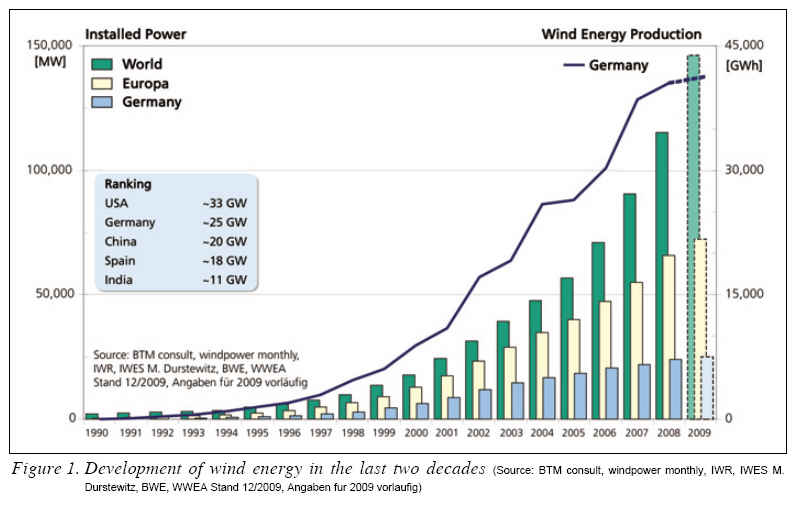
Development of Generation
In the past years, the amount of grid-connected generation based on renewable energy sources has increased to a point where it is not negligible anymore. Due to its nature, this type of generation is not only geographically dispersed but also distributed across several voltage levels. As Distributed Generation (DG) began to grow, utility companies started having problems handling the increasing amount of uncontrolled generation up to the point where significant security-of-supply risks arouse at some points of the network. One of the most important problems was, in fact, that DG was not required to provide the contributions to grid stability that conventional generators were obliged to1).
The first considerable repercussions of this unplanned connection of DG arrived with large wind farms that began connecting to the transmission level. A well-known operation criterion at this level is commonly known as ¡®N-1¡® which dictates that the transmission network must continue working even if a failure of one of its components occurs. Under normal circumstances, a fault of, let¡¯s say, a transmission line would be isolated by the installed protections and the system would continue its normal operation. Nevertheless, during the fault some of the grid¡¯s parameters--such as the voltage--may be drawn outside their nominal values.
Wind parks installed before 2004 would disconnect themselves from the network when a large disturbance occurs. This resulted in a considerable amount of uncritical faults being aggravated by the loss of generation of neighboring wind parks.
In order to minimize the risks, Germany¡¯s transmission network operators launched in 2007 the Transmission Code, which began describing the minimum requirements regarding dynamic voltage support and provision of reactive power for distributed generation plants connected to transmission networks.
In the last years, as the amount of generation in the medium-voltage distribution levels increases, it has become important to define a similar set of rules for the operation of DG in this realm. For this effect, Germany¡¯s Federal Association for the Management of Energy and Water (BDEW) published in June 2008 a new code for the connection and operation of generation plants connected to medium voltage networks2), which aims to the effective integration of DG into the network structure on distribution networks.
This new code affects market sectors that were left--up to now--ractically unaffected by the Transmission Code: Medium-sized CHPs, large PV plants, small wind parks, etc. The objective of this work is to provide an overview of the most important requirements, their scope and an outlook on how these requirements may influence other countries¡® standardization activities.
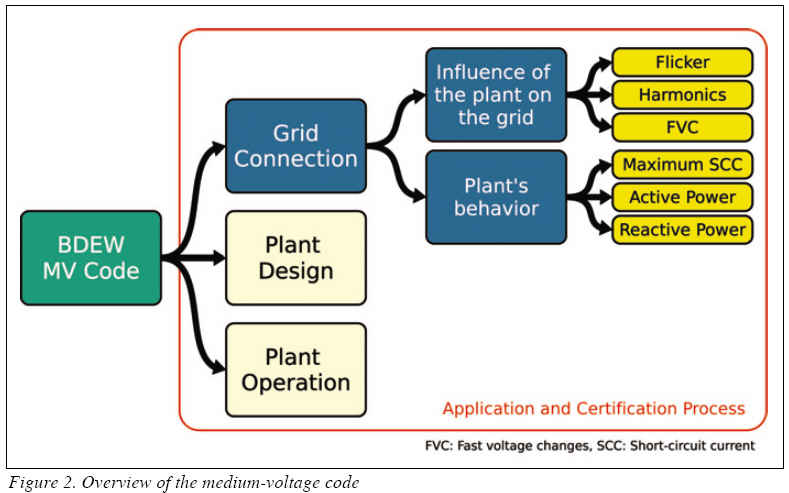
The BDEW Medium-Voltage Code
Germany¡¯s code for generation plants connected to medium-voltage networks was completed in June 2008 and came into effect on January 1st, 20092), although there has been an amendment3) with extended deadlines for PV, fuel cells and combustion-engine-based generators. The new code is one of the efforts of system operators towards the integration of large amounts of Distributed Generation (DG) into the network. Figure 2 presents an overview of the code with a focus on the aspect: ¡®Grid Connection¡® which is the main aspect that will be discussed.

Scope
The code is to be fulfilled by all generation plants that are to be connected through the medium-voltage network either direct or through a dedicated transformer. Because of the latter, this scope includes some generation units, which are typically connected to the low-voltage level such as PV inverters when they are clustered to achieve larger power levels (such as megawatt PV plants).
Figure 3 shows a typical example of an inverter-based generation plant which is required to comply with the new code. Whenever the installation requires the use of a dedicated MV transformer the plant must be able to comply with the code.
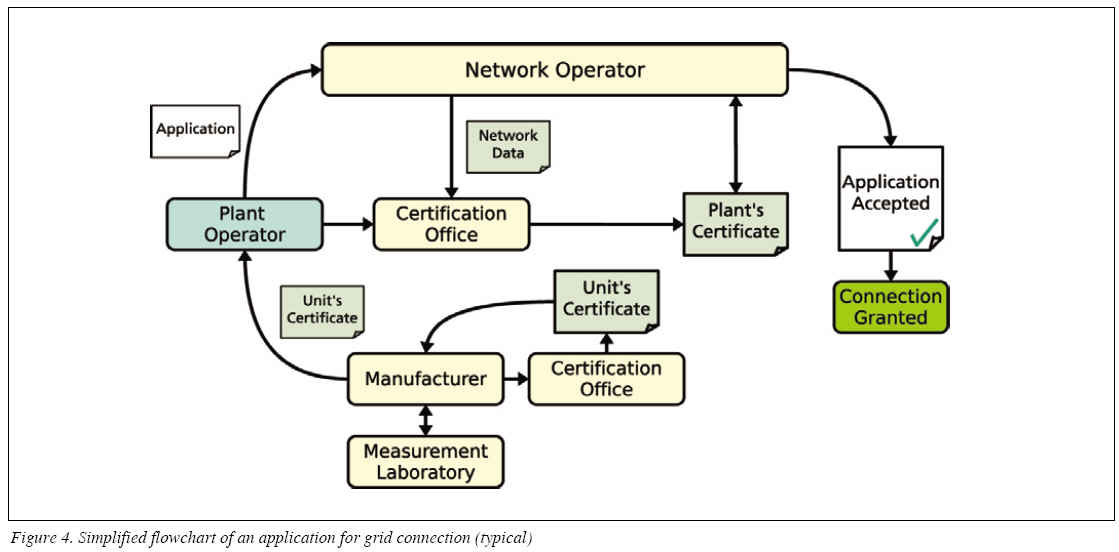
The Certification Process
The code foresees a certification process as the standard procedure for granting a grid connection to a plant. Figure 4 presents a simplified overview of what that process may be. Ideally, the plant operator gathers information of the plant it wants to install. This includes generation units and plant design.
Each major component in a plant (e.g., generation and compensation units) must present a certificate, which includes a model of the unit. The certificates as well as the models are based on measurements and are usually held by the manufacturer, which then may hand them to the customer.
With the units¡® certificates and network data of the possible connection point (provided by the grid operator), a certification office may then check the compliance of the plant to the code. If the design fulfills the requirements, a plant certificate is issued. With a valid certificate, the network operator may grant the requested connection.
Grid Connection Requirements
¡®Grid Connection¡® requirements are stated on the code as the requirements of the electrical characteristics of the plant at the point of common coupling. It is divided in two main sections: ¡°influence of the plant on the grid¡° and ¡°plant¡®s behavior¡°.
Plant¡¯s Influence on the Grid
The code describes the maximum interference levels that generation plants are allowed to produce. These limitations have the objective of assuring the required power quality levels and avoiding device interference. The code defines the following rubrics:
-Fast Voltage Changes: Changes produced by the connection and disconnection of one or several units and/or switch gear in the plant.
-Long-time Flicker: Mostly produced by very fast changes (in the range 8-10 Hz) in the primary energy source (e.g., wind) or a coupling between control loops.
-Harmonics/Interharmonics: High-order frequency components in the injected current, which result in voltage distortions.
-Commutation Dips: Voltage dips or notches related to grid-switched devices like thyristor-based inverters.
-Telecontrol signals: Interference with the operator? telecontrol system (e.g., street lighting)
The compliance to these requirements is usually made by comparing the measured results, calculating the aggregated effect of the generation units at the point of common coupling and comparing them with the applicable limits. There is usually no simulation model required.
Plant¡®s Behavior
As said in previous sections, DG units should be able to contribute to the stability of the grid. In this topic, the German code stipulates requirements for both normal operation and reaction under fault conditions.
Static Voltage Support
When the system operator requires it, generation plants must be able to participate in the static voltage support in order to compensate for slow voltage variations and maintain the voltage under the permissible voltage levels. For this purpose, several requirements regarding reactive power injection capabilities have been outlined.
1. The generation plant must be able to set at least a power factor of 0.95 (both, leading and lagging) at all power levels.
2. In addition, the system operator must be able to give a signal for controlling at least one of the following control schemes:
a. A fixed power factor cos(¥õ)
b. A displacement factor cos(¥õ) = f(P)
c. A fixed reactive power value Q
d. A voltage regulation characteristic Q = f(U)
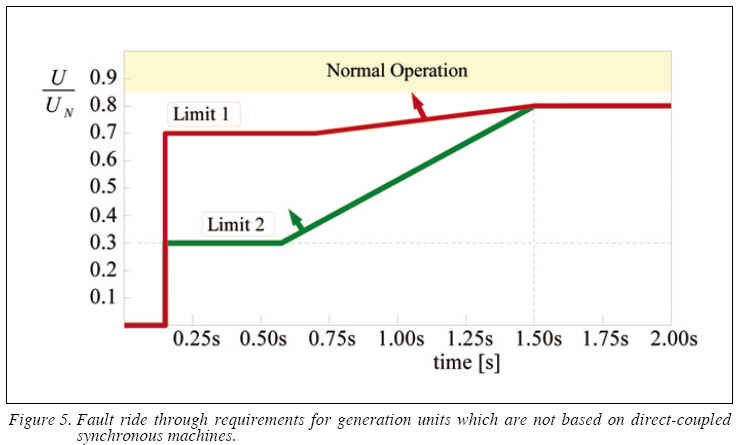
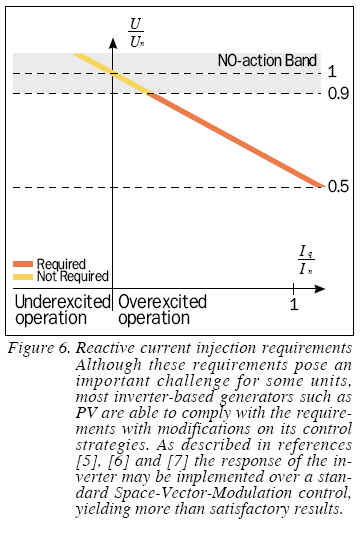
Dynamic Voltage Support
All generation plants are required to provide dynamic voltage support (support under fault conditions). This is in other countries known as Fault-Ride-Through or Low-Voltage Ride-Through. The specification requires, which means that generation plants must:
1. Be able to remain connected to the grid during the presence of a fault.
2. Be able to help in the voltage support process during the fault by injecting lagging reactive current in the grid.
3. Not consume more reactive power after the fault than before the fault occurred.
Figure 5 shows the requirements regarding the first point. As it may be seen, the plant must remain connected to the grid and inject reactive power during the first 150 ms of any fault. The regulation makes a distinction between generators based on synchronous machines and other kinds of generators. In general, all generators must remain connected and inject a 90¡Æ lagging current proportional to the voltage dip for faults lying over limit line 1. This applies for both symmetrical and unsymmetrical fault conditions.
Generators which are not based on synchronous machines must remain connected on all faults lying over limit line 2, however, under limit line 1 and over limit line 2, there is no current injection requirements.
A more exact value of the required reactive current in terms of dynamic voltage support is defined as shown in Figure 6. It may be seen that a converter must inject a current which is at least 2% of the nominal current for each 1% voltage dip under the minimum normal operating voltage until it arrives to the nominal value.
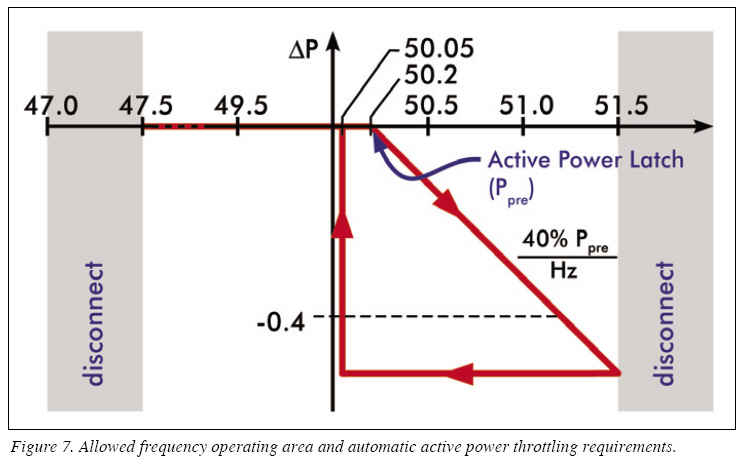
Active Power Throttling
Studies such as that on reference 8 have demonstrated that ¡°the frequency behavior of small generators in distribution grids considerably influences grid stability in interconnected power systems. In the cases where large distortions occur as well as under normal operation, small generators and loads actively support the frequency control¡°. In the case of any potential frequency stability issue, Germany¡¯s MV code provides the network operator with the possibility to reduce the amount of produced power by the generation facilities. For this purpose, the plant must provide means for reducing its output power. The active power throttling must be implemented in the following two manners:
1. Manually, by using a control signal which is to be given by the Network operator.
2. Automatically when detecting an overfrequency.
The reduction must be implemented in a maximum of 10% steps from 100% to 0% of the contracted power. To allow for an equally fast restoration of the generation, the plant must be able to remain connected to the grid for any set point over 10%.
The automatic throttling is required for the cases where larger disturbances to the frequency stability arise. In this case, as Figure 7 depicts, the active power reduction is a proportion of the (pre-dristurbed) power based on the frequency deviation from the maximal operation frequency of 50.2 Hz. The requirement also includes a hysteresis. The reduction should implement a slope of 40%/Hz with the hysteresis threshold being at 50.05 Hz.
Repercussion on Grid Codes
Germany¡¯s new medium voltage code aims for an effective integration of distributed generation into the current network structure; in which DG is not seen as a threat but as a helpful ally for providing habitual power quality and security-of-supply levels. Current national and international standards development suggest that this code is likely to have a repercussion on grid codes for other countries in and outside the European Union. It is, therefore, of great importance to throw a glance at this country¡¯s requirements.
These requirements pose several challenges to manufacturers of distributed generation units and while some of them may need to undergo major design changes, the necessity of having power generation that contributes to the security of supply of the current and future grid is of the foremost importance.
Antonio Notholt is with the Fraunhofer Institute for Energy Systems Technology IWES in the area of grid integration of inverter-based distributed generation into electricity grids (http://http//iwes.fraunhofer.de).
REFERENCES
1) A. Notholt. ¡°Fault ride through capabilities of inverter-based generators connected to low- and medium-voltage distribution networks¡±, PhD Dissertation 2009. University of Kassel.
2) BDEW Berlin. ¡°Technische Richtlinie Erzeugungsanlagen am Mittelspannungsnetz¡±. Edition June 2008. Federal association for the management of energy and water (BDEW), Berlin.
3) BDEW Berlin. ¡°Erg nzung zur Technische Richtlinie: Erzeugungsanlagen am Mittelspannungsnetz Stand Juni 2008¡±. January 2009. Federal association for the management of energy and water (BDEW), Berlin.
4) Leon, J. et al., ¡°New Space Vector Modulation Technique for Single-Phase Multilevel Converters¡±, IEEE International Symposium on Industrial Electronics. ISIE 2007. June 2007 pp. 617-622
5) P. Rodriguez et al. ¡°Flexible Active Power Control of Distributed Power Generation Systems During Grid Faults,¡± IEEE Trans. on Industrial Electronics, vol. 54, n . 5, Oct. 2007
6) F. Blaabjerg et al. ¡°Overview of control and grid synchronization for distributed power generation systems,¡± IEEE Trans. Ind. Electron., vol. 53, no. 5, pp. 1398-1409, Oct. 2006.
7) A. Notholt. ¡°Fault Ride Through capabilities of inverter-based distributed generation connected to low and medium voltage distribution networks¡±. Dissertation 2008. Dr. Hut Verlag. ISBN: 978-3899639247.
8) P. Strau¥â, Einfluss des Frequenzverhaltens kleiner Generatoren und Lasten auf Stromnetze unter besonderer Ber cksichtigung
For more information, please send your e-mails to pved@infothe.com.
¨Ï2010 www.interpv.net All rights reserved.
|



